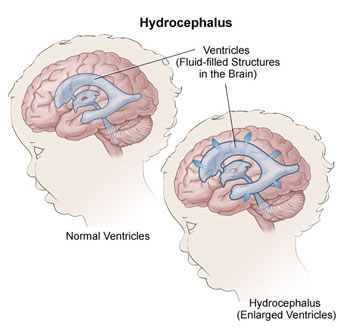Obstructive hydrocephalus derives its name from the Greek words hydro (water) and kephale (head), so the condition is sometimes referred to as "water on the brain". Cerebrospinal fluid (CSF) is a clear fluid that is present in the brain and spinal cord to help prevent injury, deliver nutrients, regulate pressure, and remove waste. CSF is produced and stored in ventricles before being absorbed into the bloodstream via the venous system. If the CSF pathways become obstructed or damaged, CSF can accumulate within the ventricular system, which can cause the ventricles to dilate and the cerebral mantle to thin and stretch. When this happens, the condition is known as obstructive hydrocephalus.
Symptoms of Obstructive Hydrocephalus
 Symptoms of obstructive hydrocephalus can be seen in both adults and kids, but they are often more visually noticeable in infants.
Symptoms of obstructive hydrocephalus can be seen in both adults and kids, but they are often more visually noticeable in infants.
- Because infants' skulls are not fully developed, the buildup of fluid can cause their head to enlarge. It is also possible for infants to form a bulging soft spot on their head, visible and concerning veins on their head and/or separation of bones in the head (as the bones in the skull are not yet closed). They may also show delayed adaptability to walking and motor functions.
- Other symptoms which are noticeable in both children and adults are nausea, headaches, poor coordination and loss of concentration.
- Adults may also experience impaired vision, vomiting and bladder control problems.
Risk Factors of Obstructive Hydrocephalus
This condition can be caused by numerous circumstances and conditions and can affect any person at any age.
- The condition is most common in adults over the age of 60 or in young children; it is estimated that 1 in 500 children are affected by the condition.
- It is also known to be a congenital condition, meaning it can be present at birth.
- This will often stem from a genetic disorder, such as spina bifida.
- In cases concerning the elderly, the hydrocephalus is usually due to an infection (such as meningitis), head injury or a brain tumor/cyst.
How to Diagnose Obstructive Hydrocephalus
There are certain strategies your doctor may devise to assess whether you have obstructive hydrocephalus.
- They will likely first discuss your medical history and what symptoms you are experiencing to try to find out the cause.
- A neurological examination may be implemented to assess your cognitive function, as well as a physical examination to test things such as walking and balance.
- An MRI or CT scan will be suggested if you are believed to have obstructive hydrocephalus.
How to Treat Obstructive Hydrocephalus
Obstructive hydrocephalus treatment depends on the severity and the cause of the condition.
- If the condition is caused by a temporary block, and no symptoms have formed from the condition, then there may be no requirement for intervention.
- It may also be suggested that you undergo a procedure to remove some CSF via a spinal tap (lumbar puncture) to see if your symptoms alleviates or clears.
- If the condition is believed to be caused by a cyst or a tumor, then surgery would be the best option. Surgery does not guarantee improvement and health care professionals have little hope of determining whether the procedure will be beneficial or not. Generally, if a patient responds well to CSF draining, then surgery will be recommended. If left untreated, symptoms can get drastically worse and even lead to death.
Know more about hydrocephalus and obstructive hydrocephalus from the video below:
